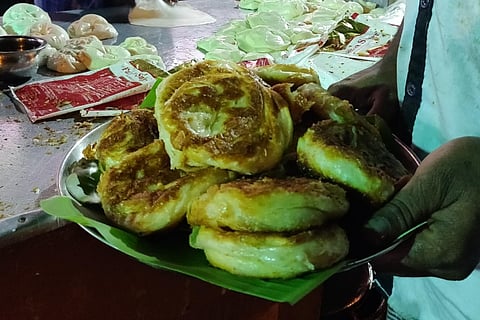

You might be familiar with the south Indian parotta (pronounced barotta/prota) in its many forms - kothu parotta, chilly parotta, parotta salna, to name a few - but have you tasted or heard of bun parotta?
If you are from Madurai, you might know of its fame but if you aren't, this cross between a bun and a parotta is a must try! Served with the choicest of sides like mutton chukka or quail (kaada) gravy, this puffed up parotta makes for a scrumptious meal.
Crispy and golden brown on the outside, chewy, flaky and soft on the inside, this Madurai special traces its origin to a roadside eatery that was started in the early ‘90s. You can head towards Madurai’s KK Nagar locality and ask anyone on the road to direct you to the roadside stall that makes and sells bun parotta.
The making of the dough in itself is a spectacle worth watching, a show that begins at 2.00 pm every day, right when Madurai’s gears reach a slow grind at mid-afternoon. If you’re stopping at the traffic signal at this junction around this time, an interesting sight awaits you.
A group of five men headed by Durai Pandi, the parotta master, scratch clean and wipe a long stainless steel table with short slabs on its three sides. This is the work table where the parotta dough will be mixed.
Several sacks of maida are emptied onto this work table. A very thin layer of the flour is blown away from the mountain, coating the pavement floor and the vehicles parked nearby with fine white dust.
The mountain’s peak is then flattened and evenly heaped to its sides to form a well in the centre where several ingredients will be mixed in quick succession. Into this well, 65-70 eggs are cracked open, six to seven litres of milk is poured and the mix is beaten well to form a smooth yellow liquid. Half a kilogram of sugar and the required amounts of salt are swiftly blended into this mix that will soon have to be buried with maida.
The dough drinks close to 75 litres of water to take its shape, and from this moment on is a carefully choreographed dance with just the hands: fingers clawing and scrunching, forearms pushing, pulling and tearing the dough apart.
In the beginning, the maida is scooped from the sides and dropped into the centre where it melts first and then starts getting thicker until it becomes an ivory mass of tough looking dough.
The men slowly move around the table, repeating their movements without a pause. It is stretched and pressed until its texture turns smooth and taut. The dough is covered in wet plastic sheets and a moist towel and allowed to rest for about 20 minutes.
The men flex their arms briefly before getting to it once again, but this time cutting it into portions and shaping them separately.
These portions, heaped one on top of the other in smooth cylindrical rolls, are made into small balls, greased with oil, ready to be rolled using the veechu method. Around 5.00 pm the first batch of bun parotta is made for the day.
For the uninitiated, the veechu can be compared to the Rumali roti from North India - thin and multi-layered parotta. In Tamil, Veechu means ‘to throw’. Here, the dough is spread thin, flipped and stretched multiple times in the air and with deft hand movements, the slim dough is twisted and rolled into a small bun sized piece. This is patted down and shallow fried on a wide pan mounted atop a coal-fired stove. Cooking oil in small amounts is poured on top of it and the smooth dough fluffs up and crisps before it is turned to its other side.
Heaping the oily bun parottas on a plate, one member from the team roughs them up, clapping the parottas in between his palms, an action that gives the veechu layers more definition.
Served with some of the spiciest meat sides, Madurai’s bun parotta is considered a treat not just by the locals but by everyone who visits the city.
The street joint Madurai Bun Parotta Kada, was started together by Karupanna and his wife Vijayam in 1991. The couple claim that it was here that the bun parotta was envisioned for the first time by their first parotta master. “We get customers from Singapore, Malaysia who come here asking for parcels. Chennai people, especially, love it. We didn’t think it would become so famous back then. Now it has become a Madurai special,” laughs Karupanna.
Karupanna
One plate of bun parotta is priced between Rs 90 and Rs 100. While the stall remained open until 2.00 am in the ‘90s, when Madurai was more vibrantly the ‘Thoonga Nagaram’, today it closes by 12.00 midnight. For indoor ambience, Madurai Bun Parotta Kadai has also opened its doors on Madurai-Kallal Road.